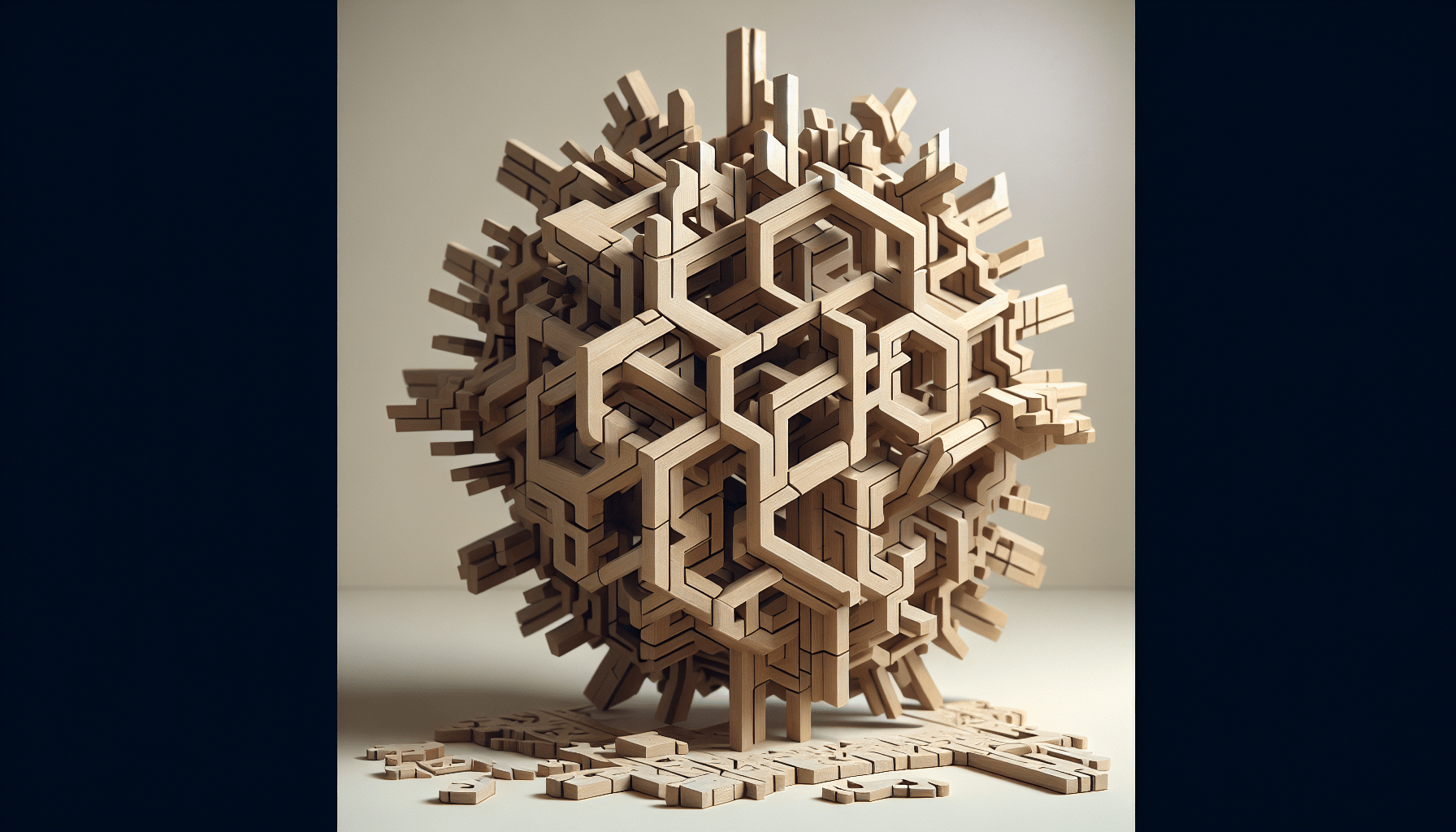Have you ever found yourself fascinated by the intricacies of 3D wooden puzzles? Whether you’ve stumbled across them in a store or seen them meticulously displayed in a friend’s living room, these beautifully crafted puzzles are intriguing. You might be wondering, “Are there different levels of difficulty for 3D wooden puzzles?” The short answer is: absolutely. However, diving deeper into this subject can provide a wealth of insights for both casual puzzlers and those on the hunt for a greater challenge.

Understanding 3D Wooden Puzzles
3D wooden puzzles are intricate, often handcrafted models that can range from simple to extraordinarily complex. They can be both decorative and functional, designed to resemble various objects such as animals, vehicles, buildings, or even miniature mechanical contraptions. Brands like Robotime, Rokr, Ugears, Wood Trick, EWA, Vitascope, Wooden City, and Handmadecity have specialized in producing these beautiful and challenging puzzles.
Why 3D Wooden Puzzles Are Popular
There are several reasons why 3D wooden puzzles have gained such popularity:
- Craftsmanship: These puzzles are often made from high-quality wood with intricate designs, making them collectibles.
- Challenge: They offer a good brain workout and test your problem-solving skills.
- Aesthetics: Beyond the challenge, they make for fantastic decorative pieces.
Levels of Difficulty
The difficulty levels of 3D wooden puzzles can generally be categorized into three groups: beginner, intermediate, and advanced. These categories are influenced by factors such as the number of pieces, the complexity of the design, and the mechanical movement in some cases.
Beginner Level
If you’re new to 3D wooden puzzles, the beginner level is a great starting point. These puzzles are relatively straightforward and don’t require extensive experience or tools.
Characteristics of Beginner-Level Puzzles:
| Feature | Description |
|---|---|
| Number of Pieces | Usually under 100 pieces |
| Design Complexity | Simple shapes and assemblies |
| Time Required | Can typically be completed in a couple of hours |
Beginner puzzles are great for kids or anyone looking to get a feel for how 3D wooden puzzles work. Examples from brands like Robotime and Wood Trick often include small animal figurines or simple vehicles.
Intermediate Level
Once you’ve become comfortable with beginner puzzles, you might seek a bit more of a challenge. Intermediate puzzles often add more pieces and complexity to make the experience more engaging.
Characteristics of Intermediate-Level Puzzles:
| Feature | Description |
|---|---|
| Number of Pieces | Typically between 100 to 300 pieces |
| Design Complexity | More detailed and may include moving parts |
| Time Required | Usually require several hours to a day to complete |
Intermediate puzzles might include more complex vehicles, intricate buildings, or mechanical models that have moving parts. Brands like Rokr and EWA offer a variety of intermediate options.
Advanced Level
For those who crave a significant challenge, advanced-level 3D wooden puzzles will test your limits. These puzzles are not for the faint of heart and will require considerable time and patience.
Characteristics of Advanced-Level Puzzles:
| Feature | Description |
|---|---|
| Number of Pieces | Often exceed 300 pieces |
| Design Complexity | Highly intricate with many detailed parts and advanced mechanical functions |
| Time Required | Can take several days or even weeks to complete |
Advanced puzzles might include elaborate mechanical clocks, large architectural replicas, or complex vehicles with moving parts. Brands like Ugears and Vitascope specialize in these intricate designs.
Factors Influencing Difficulty Levels
Several factors determine the difficulty level of 3D wooden puzzles, including:
Number of Pieces
Generally, the more pieces a puzzle has, the more challenging it will be. However, it’s not just about quantity. Larger numbers of very similar pieces can make the puzzle more difficult because it requires more attention to detail in assembly.
Complexity of Design
A more intricate design often means more small, detailed parts, which can make the assembly process more complicated. The design complexity also influences the visual instructions, which could be harder to follow for more advanced models.
Mechanical Elements
Some 3D wooden puzzles come with mechanical features. The integration of gears, springs, and other moving elements can significantly raise the puzzle’s difficulty level. These mechanical elements often require precise assembly to function correctly.
Level of Detail in Instructions
The quality and clarity of the assembly instructions can also play a big role. Beginner puzzles usually come with detailed, step-by-step visual instructions. As you move up in difficulty, the instructions might become less detailed, requiring you to rely more on your understanding and intuition.
Popular Brands and Their Difficulty Levels
Several reputable brands produce 3D wooden puzzles, each offering different levels of difficulty to cater to a wide audience. Let’s take a closer look at some popular brands and what they offer:
Robotime
Range of Difficulty: Beginner to Intermediate
Robotime offers a wide range of 3D wooden puzzles suitable for beginners and intermediates. Their designs often feature iconic structures, simple vehicles, and mechanical movements that provide a moderate challenge.
Example Products:
- Airplane Model: Great for beginners with fewer pieces and a straightforward design.
- Orpheus Music Box: An intermediate puzzle with moving parts and a musical element.
Rokr
Range of Difficulty: Intermediate to Advanced
Rokr now specializes in more complex designs, often featuring a steampunk aesthetic. Their puzzles often include moving mechanical parts and can be quite challenging.
Example Products:
- Marble Run Set: Intermediate, with intricate paths for marbles to navigate.
- Locomotive Model: Advanced, with complex mechanical parts.
Ugears
Range of Difficulty: Intermediate to Advanced
Ugears is well-known for producing highly intricate mechanical models. Their puzzles often resemble historical machines and complex mechanical devices, perfect for experienced puzzlers.
Example Products:
- Tractor Model: Intermediate with some mechanical elements.
- Combination Lock: Advanced, requiring high precision in assembly.
Wood Trick
Range of Difficulty: Beginner to Intermediate
Wood Trick offers a balanced mix of simple and moderately challenging puzzles. Their kits often include vehicles and small architecture models, making them great for family activities.
Example Products:
- Formula Car: Beginner, with a simple assembly process.
- Eco-Wood Art Tower: Intermediate, with detailed parts.
EWA
Range of Difficulty: Intermediate to Advanced
EWA specializes in puzzles with a medieval or fantasy theme. Their models often feature moving parts and elaborate designs.
Example Products:
- Dragon Model: Intermediate, with dynamic poses and movable parts.
- Medieval Castle: Advanced, with numerous detailed components.
Vitascope
Range of Difficulty: Advanced
Vitascope focuses on creating highly detailed and mechanically complex models. Their puzzles are suitable for those looking for a serious challenge.
Example Products:
- Vintage Projector: Advanced, with operational mechanical elements.
Wooden City
Range of Difficulty: Intermediate to Advanced
Wooden City offers a variety of intricate models, focusing on functional mechanical puzzles and beautifully detailed designs.
Example Products:
- Gondola: Intermediate, featuring moving parts.
- City Tram: Advanced, with elaborate mechanisms.
Handmadecity
Range of Difficulty: Beginner to Intermediate
Handmadecity offers unique puzzles often made from natural wood, with simple to moderately complex designs.
Example Products:
- Animal Figurines: Beginner, easy to assemble.
- Small Architecture Models: Intermediate, requiring more detailed assembly.

How to Choose the Right Difficulty Level
Choosing the right 3D wooden puzzle can depend on several factors, such as your experience level, interest, and the amount of time you’re willing to invest. Here are some tips to help you decide:
Assess Your Skill Level
- Beginners: Start with puzzles that have fewer pieces and simpler designs to get a feel for the assembly process.
- Intermediate Puzzlers: Opt for puzzles with more pieces and some mechanical elements to challenge your problem-solving skills.
- Advanced Puzzlers: If you’re experienced and looking for a serious challenge, choose puzzles with a high piece count and intricate moving parts.
Consider Your Interests
Selecting a model that aligns with your interests can make the puzzling experience more enjoyable. Whether you’re fascinated by historical artifacts, mechanical gadgets, or architectural wonders, there’s a 3D wooden puzzle to match your taste.
Time Commitment
Think about how much time you’re willing to spend on your puzzle. Beginner puzzles can be completed in a few hours, while advanced puzzles might take several days or weeks. Make sure you have the time and patience required for more complex models.
Benefits of Solving 3D Wooden Puzzles
Solving 3D wooden puzzles isn’t just a fun activity; it comes with several benefits:
Cognitive Benefits
- Improves Problem-Solving Skills: Figuring out how pieces fit together enhances your ability to solve complex problems.
- Boosts Memory: Remembering where certain pieces go and following instructions can improve your memory.
- Enhances Concentration: The focus required in assembling these puzzles can help improve your attention span.
Emotional Benefits
- Reduces Stress: Engaging in a focused and creative activity can help reduce stress and anxiety levels.
- Sense of Accomplishment: Completing a puzzle gives a significant sense of achievement and satisfaction.
Social Benefits
- Family Bonding: Working on puzzles with family members can be a great way to bond and collaborate.
- Community Building: Sharing your puzzle experiences and achievements can help you connect with like-minded enthusiasts.
Common Challenges and How to Overcome Them
Even experienced puzzlers can face challenges when assembling 3D wooden puzzles. Here are some common issues and tips on how to overcome them:
Incorrect Assembly
If you mistakenly assemble pieces incorrectly, it can be frustrating and time-consuming to correct.
Solution: Always double-check the instructions and assemble step-by-step, ensuring each piece fits as intended before moving on.
Missing Pieces
In rare cases, puzzles may come with missing pieces, making it impossible to complete the model.
Solution: Contact the manufacturer’s customer support for replacement parts. Many reputable brands are happy to assist with missing components.
Difficulty Understanding Instructions
Sometimes the instructions may seem unclear or overly complicated.
Solution: Look for online tutorials or community forums where other puzzlers may have shared tips and assembly videos.
Tight or Loose Fitting Pieces
Wooden pieces might sometimes be too tight or too loose, affecting the stability of the puzzle.
Solution: Use fine sandpaper to gently adjust tight pieces, or apply a small amount of wood glue on loose parts for added stability.
Tips for Assembling 3D Wooden Puzzles
Here are some handy tips to make your puzzling experience smoother and more enjoyable:
Organize Your Pieces
Before you start, sort all the pieces by type and size. This can make it easier to find the parts you need as you follow the instructions.
Follow Instructions Carefully
Pay close attention to the assembly guide and follow each step without rushing. Skipping steps or doing them out of order can complicate the assembly process.
Use Appropriate Tools
A small hammer for gently tapping pieces into place, fine sandpaper for adjustments, and tweezers for handling small parts can be very useful during assembly.
Take Breaks
If you find yourself getting frustrated or tired, take a break. Coming back with a fresh perspective can often make the puzzling process easier and more enjoyable.
Final Thoughts
Indeed, there are different levels of difficulty for 3D wooden puzzles, ranging from beginner to advanced. Brands like Robotime, Rokr, Ugears, Wood Trick, EWA, Vitascope, Wooden City, and Handmadecity offer a wide range of options to suit varied skill levels and interests. Whether you’re a newbie looking for a fun activity or an experienced puzzler seeking a formidable challenge, there’s something out there for you.
Understanding the factors that influence difficulty levels, knowing how to choose the right puzzle for your skill level, and applying helpful tips can make your puzzling experience both enjoyable and rewarding. So, are you ready to tackle your next 3D wooden puzzle challenge?